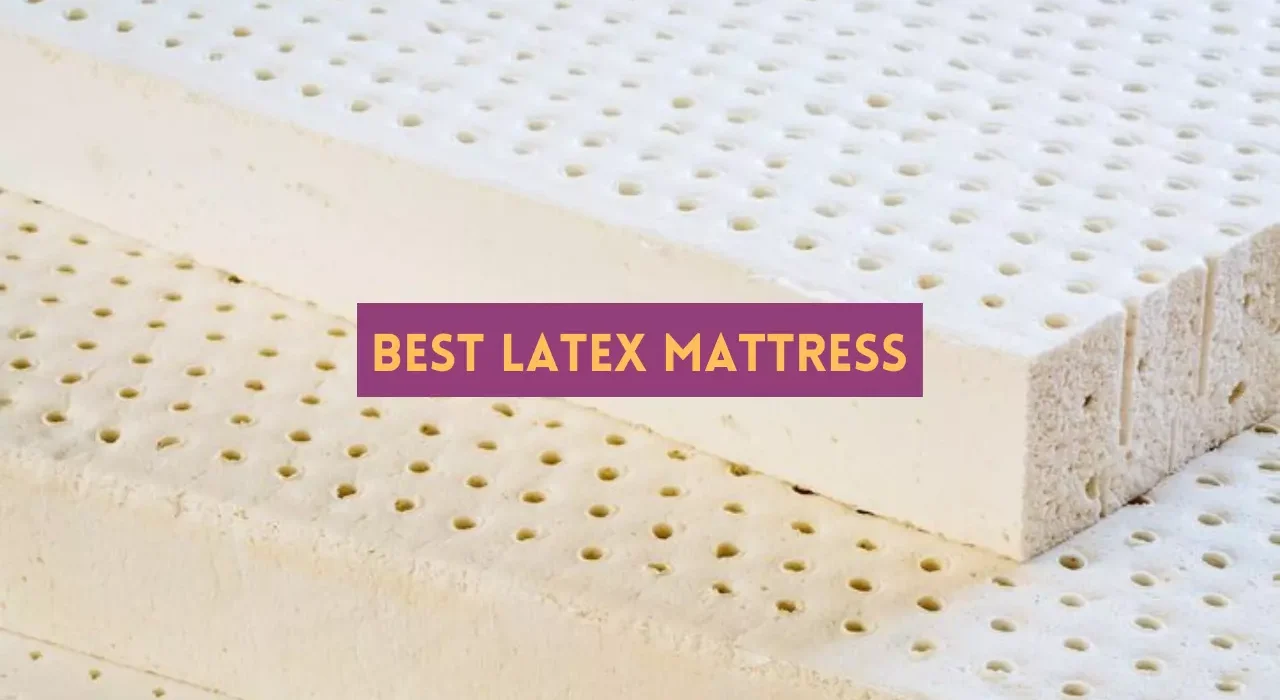For decades, latex was viewed as only a luxury mattress option, out of reach for most customers. In recent years, though, latex has become more affordable thanks to the increasing availability of online mattress retailers, and now, latex mattresses offer excellent performance and value while remaining within the budget of most mattress shoppers.
The majority of the latex used in today’s mattresses is high-quality, naturally sourced from rubber trees and produced using the Dunlop or Talalay manufacturing process. All-latex beds are made using only latex while latex hybrids employ other materials, such as foams or innerspring coils, as well.
Latex has a unique feel that blends contouring, resilience, and comfort. Latex mattresses are available in a compelling mix of designs and firmness options. Key selling points include their temperature regulation, natural bounciness, and conforming ability that offers relief from back and shoulder pain. They are also denser, heavier mattresses that can provide stability and above-average support for sleepers with a higher body weight.
As new latex beds have come on the market, customers have more choices than ever. In this guide, we’ll identify our top picks for the best latex mattresses. We’ll also review the essential background about latex beds to help you be a smart and savvy mattress shopper.
What Are the Best Latex Mattresses?
As the number of latex mattresses available has expanded, it has become easier for customers to become overwhelmed when trying to choose between them. Sorting through all the details and reviews can be a tedious process, so we’ve done the hard work for you and outlined our top 5 choices — which are not in a ranked order — in the table below.
Best Latex Mattress Buying Guide
What Are the Types of Latex Mattresses?
The term latex mattress is used broadly to describe a whole category of mattresses. Not surprisingly, then, not all latex beds have the same materials or construction. This section introduces the most important differences among the types of latex mattresses.
All-Latex and Latex Hybrids
Some latex mattresses have an internal construction that is entirely latex. These may be called all-latex or true-latex mattresses. In these mattresses, the latex is usually arranged in layers, and those layers may utilize different types of latex or latex with varying properties of firmness. Even an all-latex mattress isn’t 100% latex, though, as other materials, like cotton or wool, are frequently used in the cover.
A latex hybrid features latex as a central part of the mattress, but it isn’t the only material used. In most cases, a thick latex layer forms the comfort system that goes on top of a support core of innerspring coils.
Of course, other types of mattresses can use latex, but that doesn’t mean they are latex mattresses. For example, a memory foam bed might have a thin latex layer nestled in among the foams. Because latex is not the central element in that mattress, it would not be considered either an all-latex or latex hybrid mattress.
What Are the Types of Latex?
Within the category of latex mattresses, some types can be distinguished based on the type of latex that is used. Latex mattresses may contain natural latex, synthetic latex, or blended latex, which is a mix of the two.
Natural Latex
Also called NR latex or pure latex, this material is derived from the sap of rubber trees. Trees produce this sap naturally, and removing the sap for latex does not harm the tree. Once the sap is removed, it can be processed into different types of latex rubber products.
Even natural latex is not 100% composed of sap. The conversion of sap into usable products requires adding a very small amount of additives to permit proper curing of the rubber. These additives are generally regarded as safe and are used only in small quantities, composing less than 5% of the final product. This means that 95% or more of the latex rubber is directly from the tree sap.
Organic Latex
All organic latex is natural latex, meaning that it is derived from the sap of trees. But not all natural latex is organic. The organic label goes beyond just being made from sap; it indicates that the way that the trees are cared for and that the rubber is made reflects principles of organic production.
For example, organic standards frequently require that no pesticides be used, that systems be in place for managing waste streams, and that systems be in place for transparency and verification of the production processes. Some organic standards also require provisions for protecting the rights and well-being of workers.
An organic certification indicates that the latex has been made according to the standards required by that specific certifying agency. As a result, not all certifications are created equal. One certification for latex that is well-regarded is the Control Union’s Global Organic Latex Standard (GOLS). GOLS includes criteria for sustainability in the cultivation and processing of sap as well as for the proper treatment of workers in this production process.
Dunlop and Talalay Latex
Natural latex for a mattress can be formed in two ways: the Dunlop process and the Talalay process. For this reason, you will frequently see latex in mattresses labeled as either “Dunlop” or “Talalay.” Both processes can make a high-quality natural latex product, but there are some notable differences in the characteristics of these materials. In the Dunlop process, manufacturers whip the sap into a froth, pour it into a mold, and then steam-bake it so that it holds its shape. During this process, some natural sediment accumulates at the bottom of the mold, resulting in a slightly denser, heavier mattress, especially on one side. Dunlop latex is often firmer and is well-regarded for its durability.
In the Talalay process, the sap is still whipped and put in a mold, but then the mold is vacuum-sealed and frozen. This stabilizes the components of the mold and prevents sediment collection. After being frozen, the mold is baked to finalize the process. Talalay latex has a more homogenous feel that tends to be lighter and slightly softer.
While the difference between Dunlop and Talalay latex is important to be aware of, remember that both processes use naturally derived sap that gives the material its fundamental properties. As a result, you’ll find moderate contouring and considerable elasticity in both types of natural latex.
Synthetic Latex
Synthetic latex, also known as Styrene-Butadiene Rubber (SBR) or SBR latex, is derived from petroleum-based chemicals. It has been chemically engineered to have a feel that is similar to natural latex, but its production does not require the harvesting of sap.
Historically, synthetic latex has been a cheaper product because of its ability to produce it without managing farms of sap-producing trees. However, because it is made with petrochemicals, its price can fluctuate significantly based on the global price of oil.
While synthetic latex is common in many types of consumer products, it is less frequently employed in mattresses. For bedding, there is a strong customer preference for natural latex, and as a result, most of the most popular latex brands are made without any synthetic latex. Very low-cost latex mattresses may use synthetic latex, but these tend to offer worse performance and durability relative to natural latex beds.
Blended Latex
As the name implies, blended latex is made with a mixture of natural latex and synthetic latex. The ratio of natural to synthetic can vary depending on the formulation needed for any specific product.
Understanding Latex Labels
To review, here’s a breakdown of what you might see on a latex label and what it means.
| Type of latex | Percentage of natural latex | Mattress components |
|---|---|---|
| Natural latex (all-latex, pure latex) | 95% or more natural latex | Natural latex foam from rubber trees with a small amount of additives for curing |
| Organic latex | 95% or more natural latex | Natural latex that has been certified to meet standards of organic production, including in small percentage of additives |
| Blended latex (latex hybrid) | Varies | Mostly synthetic latex mixed with some natural latex; the exact ratio may or may not be listed |
| Synthetic latex (SBR latex) | 0% natural latex | All synthetic latex foams |
What Are the Components of a Latex Bed?
Like most mattresses, a latex bed is composed of multiple layers, and those layers allow us to determine its type. Each layer serves as part of a specific element in the mattress construction.
The Support Core
The support core is the thickest part of a mattress. It provides a base level of stability and the bulk of the height of a mattress. Because it makes up a sizable percentage of the total mattress, it also plays a role in the performance of the mattress with regard to support and bounce.
In an all-latex mattress, the support core is made with one or more thick latex layers. Because of its density, Dunlop latex is used more frequently for a support core, but Talalay latex can function extremely well in this role as well. A latex support core is sturdy and durable, helping all latex mattresses hold up well to nightly use over the long term. At the same time, the latex offers enough responsiveness to keep the mattress from feeling overly rigid.
The Comfort System
The comfort system is placed above the support core and is the part of the mattress designed to be most immediately felt by the sleeper. The contouring, bounce, and firmness of a mattress are directly influenced by the comfort system. In some beds, the comfort system is just one layer; in others, it is made up of multiple layers working together.
In both all-latex mattresses and latex hybrids, the comfort layer prominently features this material. Both Dunlop and Talalay latex can offer impressive performance in the comfort system with Talalay offering a slightly softer and bouncier feel in general.
Latex comfort layers provide multiple features that customers love. They have enough conforming to cushion pressure points, but their resilience means that there’s little risk of feeling stuck in the mattress. The bounce makes it easy to change sleeping positions or to engage in intimate activity on the bed. At the same time, the bounce isn’t so extensive as to cause problems with motion isolation. Latex does not retain significant heat, plus many latex comfort layers are aerated with small holes to let cooling airflow pass through.
The Transition Layer
Not all beds have a transition layer. Some mattresses, though, especially latex hybrids, may have a layer that sits between the support core and comfort system. Usually, this layer is denser than the comfort system but not as dense as the support core. It may be used to give a bit of extra cushioning and to make sure that sleepers don’t “bottom out” through the comfort system and put excess pressure on the support core.
The Cover
The last component of a latex mattress is the cover. A cover goes around the mattress, although it may be made of a different material on the top than on the sides and bottom. Cotton and polyester are both frequently used in mattress covers. Wool, which is soft and breathable, is often quilted with cotton to create a thicker cover with more cushioning built into it.
What Does It Feel Like to Sleep on a Latex Mattress?
Latex beds offer a unique feel that has made them a favorite among many sleepers. Thanks to their rubber content, they’re naturally elastic, so they’re excellent at accommodating pressure points while keeping a bouncy feel. The stability and moderate conforming make latex excellent at providing relief to people who struggle with back or hip pain.
In many ways, latex mattresses offer a perfect middle ground between innerspring and memory foam beds. They contour to the sleeper’s body like a memory foam mattress but without making them feel trapped or stuck. In addition, like an innerspring, they resist overheating and are bouncy enough to facilitate sex.
ILD and Density
Of course, not every latex mattress has the same feel. The latex can be produced and layered in order to provide a softer or firmer sleeping surface.
A term that you may come across that can affect the feel of a latex mattress is ILD, which stands for Indentation Load Deflection. ILD measures how much force must be applied to a material to cause it to compress a specific amount. ILD in latex materials usually ranges from 15 to 45, and the higher the ILD rating, the firmer the latex.
Keep in mind, though, that the ILD number alone doesn’t tell the whole story. ILD is affected by how thick the latex is, and it doesn’t communicate anything about the material’s responsiveness. In addition, the feel of a mattress is created by all of its layers, so looking at the ILD of just one layer can be misleading about the performance of the mattress as a whole.
Another term that is sometimes used to describe latex mattresses is density. In latex mattresses, this density usually ranges from 60 to 95 kilograms per cubic meter (kg/m3). Sometimes it is represented by the letter D followed by a number, like D75. A denser latex will usually be firmer and may be more durable as well.
What Are the Pros and Cons of Latex Mattresses?
Latex beds offer many advantages, but, like anything, they also come with their downsides. Review the list of pros and cons below to determine whether a latex mattress is right for you based on your sleep needs.
Above-average contouring
Latex mattresses are known for offering solid pressure point relief. They generally have moderate contouring relative to the deeper hug of memory foam. Of course, a softer latex mattress will be inclined to contour more than a firmer one.
Resilient sleeping surface
While latex conforms to the body, it is still an elastic material, so when your body moves, the latex quickly rebounds to its original shape. This is part of what keeps you from feeling like you’re sleeping on quicksand, and it’s especially useful for people who frequently adjust their sleeping position in the night.
Bouncy surface suitable for sex
Due to their elasticity, latex mattresses have a bounciness similar to innerspring mattresses that recover quickly from applied pressure, facilitating quick movements such as those associated with sexual activity.
Temperature regulation
Latex does not retain heat like many other mattress materials, and the cover of many latex mattresses often employs materials, like cotton and wool, that are breathable and promote comfort cooling. Many latex comfort layers are aerated with tiny holes that allow for cooling ventilation. As a result, latex is a favorite among people who sleep hot but still want moderate contouring.
Eco-conscious
While not all latex is eco-friendly, many mattress brands focus on using only natural or organic latex. Organic latex, in particular, meets high standards for being environmentally friendly.
Solid motion isolation
Though not quite as effective as memory foam at isolating motion, most people who share a latex mattress find that they are rarely bothered by the movement of a partner on the bed.
Quiet
Latex mattresses make minimal noise and rarely cause disruptions when sleeping or using the mattress for amorous activities.
Long lifespan
Compared to many other mattress materials, latex gets high marks for durability. Most all-latex or latex hybrid mattresses can be expected to last a minimum of 6 years. Many will last 10 years or longer.
Does not have deep hug
Depending on your perspective, the more moderate contouring from latex can be a benefit or a downside. While most customers like the level of conforming offered by latex, customers who want significant hug from their mattress may find a latex mattress to be lacking.
More motion transfer than memory foam
Though most sleepers don’t find motion transfer on a latex bed to be an issue, there is less motion isolation when compared to traditional memory foam. For people who are very sensitive to this, the bounce of latex may be a negative.
Heavier and more unwieldy
Though latex tends to be durable and sturdy, that comes with a negative, which is the weight of the mattress. Latex beds can be quite heavy, making them more difficult to carry if you have to move.
Higher price point
While prices have come down significantly in recent years, latex mattresses are often still more expensive than other mattress types. There are very few bargain basement latex mattresses, especially ones that feature natural and organic latex.
Latex allergies
Though not common, some people are allergic to latex and cannot sleep on a latex mattress.
How Much Does a Latex Mattress Cost?
The average price of a latex mattress has changed quite a bit in the past few years. Historically, latex mattresses were almost always a minimum of $2,000 for a Queen. Some models, such as those with organic latex, had price tags that went far above that $2,000 figure.
Now, things have changed. In today’s market, there are solid latex mattress options available in a Queen for under $1,000. Luxury models, including some in this guide, are still available, but even those have become more affordable than in the past. As with all mattresses, the price can depend on the quality of the materials and the features built into the mattress design.
Thanks to the durability of latex, though, even when these mattresses have a higher price tag, they are usually worth it because they provide an investment for the long-term.
How Long Does a Latex Mattress Last?
As we’ve mentioned earlier, one benefit of latex beds is their durability. On average, latex mattresses last longer than most other mattress types. This is especially true for organic or natural latex mattresses. In most cases, these mattresses will last 8-10 years and in some cases much longer.
It is rare for latex to have defects, but virtually all latex mattresses will come with a warranty that protects you in case the materials or workmanship show signs of a defect. This won’t cover normal wear-and-tear but will offer a remedy if something goes wrong prematurely. Most latex mattress warranties last for 10 to 25 years.
What Type of Sleepers Are Best Suited to a Latex Mattress?
Every sleeper is different. When choosing a mattress, the top focus should be on finding one that keeps your spine in alignment. Latex mattresses can offer solid support to sleepers of virtually any body weight and in any sleeping position, but it’s important to optimize the feel and responsiveness of the bed.
- Side sleepers usually do best with a slightly softer latex mattress, generally with a Medium to Medium Firm feel and a medium amount of contouring that can cushion their shoulders and hips.
- Back and stomach sleepers often love latex beds because they can cushion the abdomen and neck without permitting excessive sink. These sleepers generally prefer a slightly more firm feel, ranging from Medium Firm to Firm.
- Because of its density, durability, and stability, latex is a top pick for people who have a higher body weight. People who weigh over 230 pounds should generally opt for a slightly firmer mattress as it will prevent them from sinking or sagging into the mattress in a way that could cause the spine to become out of alignment.
Certain features of latex can make these mattresses stand out for some other specific shoppers as well.
- Eco-friendly consumers will appreciate natural or organic latex mattresses. They’re made from tree sap and don’t involve the use of heavy petrochemicals that go into many other types of mattresses. Organic certifications can add extra comfort that a latex mattress is sustainable.
- Couples, especially those who are very sexually active, tend to value the bounce in a latex bed. With solid motion isolation, latex tends to work for couples when they’re sleeping as well.
- Hot sleepers find that latex is one of the best options for keeping them cool through the night. Both all-latex and latex hybrids tend to be above-average to excellent when it comes to temperature regulation.
Latex Mattress FAQ Checklist
As you shop for a latex bed, the following list of questions can come in handy for knowing the details and picking an option that will suit your needs.
- What type of latex bed is it (all-latex or latex hybrid)?
- What type or types of latex are used in the mattress?
- How are the interior layers of the mattress arranged?
- What is the firmness feel? If listed, what are the ILD and density of the layers?
- What material is used for the mattress cover?
- What is the price? Are any discounts or promotions available to sweeten the deal?
- Does the mattress come with free shipping?
- How much does the mattress weigh? How easy will it be to set up or move?
- How long is the sleep trial?
- How long is the warranty and what does it cover?














